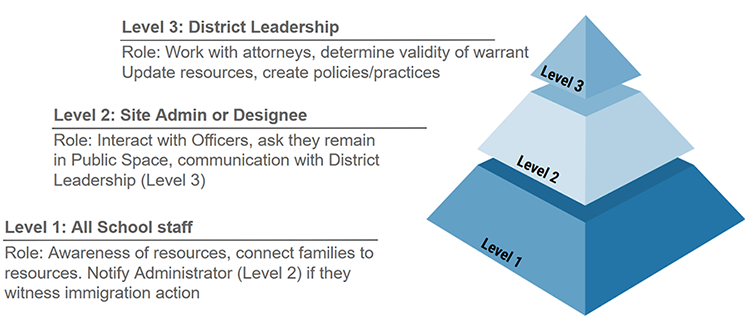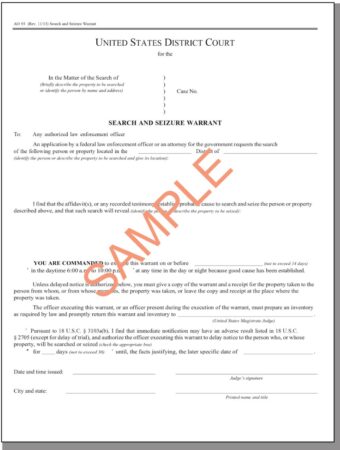Protocols Prior to Immigration Action
Essential Concept: Public vs. Private Spaces
Schools are divided into public and private spaces. Public spaces—such as parking lots and the main office lobby—are generally accessible to the public, including immigration officers. All other areas of campus (classrooms, hallways, fields, restrooms, etc.) are considered private spaces. Immigration officers may only enter these areas with a valid judicial warrant signed by a judge.
Different Roles for Responding to Immigration Action

Preparations Prior to Any Immigration Action on Campus
Assign Leadership
Identify a Level 2 Administrator to take the lead in implementing protocols.
Designate a backup administrator in case the lead is unavailable.
Campus Safety Measures
Post signage clearly separating public and private spaces on campus.
Communication Protocols
Identify a staff member who is responsible fo communications and designate a backup.
Develop and maintain a communication list (school staff, district leaders, COE, legal counsel, community partners).
Ensure software systems are prepared to send school-wide alerts via text, email, and phone.
Draft two pre-approved messages:
To notify the school community of the presence of immigration agents on or near campus.
To notify the school community when immigration agents have departed.
Training and Readiness
Review these protocols with staff.
Print and keep a hard copy of protocols accessible at all times.
Support for Smaller Schools
Charter schools and small districts may rely on the County Office of Education to act as their District Office for support and coordination.
PROTOCOLS for immigration action
Step 1: Immediate Notification
As soon as staff become aware of immigration officers on or near campus, they must notify the site administrator and District Office without delay.
Staff (other than administrators) must not engage directly with immigration officers.
The District Office will deploy Cabinet-level administrator(s) to the site immediately.
Step 2: Administrator Response
The site administrator (or designee) must:
Make contact with the agents and remain with them at all times.
Ask the immigration agents to identify themselves and state the purpose of their visit, including whether they seek information or access to individuals.
Inform them they may not enter non-public areas of the campus without a valid judicial warrant.
Step 3: Documentation and Verification
Record all names, interactions, and requests made by immigration agents.
Collect and scan any documentation provided, and immediately forward it to the District Office.
Inform immigration agents that all requests require approval from the Superintendent’s Office and review by legal counsel.
If a judicial warrant is presented, the Superintendent’s Office and legal counsel must confirm its validity before any action is taken.
No student information may be released unless specifically required by a valid judicial warrant or court order.
Step 4: Access and Student Interviews
Immigration Agents may only be granted access if explicitly authorized by the Superintendent’s Office and legal counsel.
If Immigration Agents request to interview a student, inform them this is prohibited without the presence of the student’s parent/guardian.
Step 5: Notify Families and Refer to Legal Support
Parents/guardians and emergency contacts must be notified immediately of any requests related to their children or their children’s information.
If Immigration Agents request to interview a staff member, provide the staff member with a Red Card and remind them they have the right to remain silent.
Families and staff should be referred to trusted legal resources, including the Santa Cruz County School Network for Immigration Support Call and SusDerechos.info.
The District will issue clear, multilingual communication to staff, students, and families.
Step 6: After-Action Process
Once immigration agents leave:
Families should be directed to trusted legal organizations such as the Community Action Board and the Watsonville Law Center. Additional resources are available at www.susderechos.info.
Ensure behavioral health and counseling support is available to all impacted students and staff.
Conduct a staff debrief to review the incident, evaluate the effectiveness of the response, and identify next steps.
Staff training
Verifying if a document is a “Valid Judicial Warrant”
If a law enforcement or immigration official presents a warrant, you have the right to examine it. Only a judicial warrant—signed by a judge or magistrate—carries the authority to allow entry beyond public spaces or access to student records. ICE-issued forms such as I-200 (Warrant of Arrest) or I-205 (Warrant of Removal/Deportation) are administrative warrants and are not judicial warrants. Reviewing a warrant is best done by an attorney working for the District.
1. Check the Signature and Title
A valid warrant must be signed by a judge, magistrate, or authorized court commissioner.
The signature block usually reads “Judge of the [Court Name]” or “Magistrate Judge.”
2. Look for Court Information
Judicial warrants include the name of the issuing court (e.g., U.S. District Court, Superior Court).
They often carry a court seal or official identifier.
3. Verify the Type and Case Number
Judicial warrants include a case or docket number tied to a criminal or civil case.
ICE administrative warrants do not come from a court and are not supported by probable cause findings.
4. Check the Scope
A judicial warrant specifies the individual, the charges, and the legal basis for action.
Administrative warrants usually only state removability under immigration laws.
5. Examine Dates and Validity
Judicial warrants state when they were issued and may include validity periods (for searches).
Arrest or bench warrants may not expire but will still have the original date and seal.
6. Confirm Judicial Authority
True judicial warrants are issued by neutral, independent judicial officers.
If the issuing entity is ICE or another law enforcement agency without judicial review, it is not a judicial warrant.
If You’re Unsure
Always consult a qualified immigration or criminal defense attorney before taking action.

